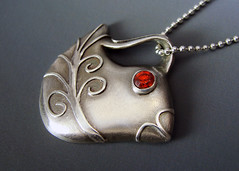Organically Inspired. . .
Search
Chickadee Swirl
 Yeah, I know. Everyone makes birds and birdhouses. There’s nothing truly original about these motifs. But, they just keep calling to me. And, my customers love them. So here’s another chickadee for your viewing pleasure.
Yeah, I know. Everyone makes birds and birdhouses. There’s nothing truly original about these motifs. But, they just keep calling to me. And, my customers love them. So here’s another chickadee for your viewing pleasure.
This one has a couple of special features. It’s formed over a polymer clay armature, which means I sculpt the form in polymer clay and bake it, then drape the sheet of metal clay over the polymer clay bird shape. It’s tricky to get the metal clay to take just the right shape, especially at the points of the beak and the tail feathers. The reason for all these steps is to have a dimensional, rather than a flat piece. Much better. I use syringe clay to form the swirling surface pattern. I like to lightly sand my syringe work down so the top of the syringe line is flat. I’m not sure why. I just like that look.
The most special and unique feature of this chickadee is the bail. I just love this flowing shape,which echoes the shape of the bird’s body so nicely. I’m jazzed about how it just flows into the head and tail of the bird. You know, bails present some unique challenges. I’ve started making more of my pieces with hidden bails on the back so they appear to float on the chain. So often, a visible bail just seems to be stuck onto a piece. It’s there out of the necessity of having a structure from which to hang the piece on its chain. And that’s why I was so pleased with this bail, which I think enhances the design of the pendant as a fully integrated element.
I usually tumble my pieces to a high shine. This piece was made shortly after I took a workshop with Gordon Uyehara, an artist known for his gorgeous matte satin finishes on silver clay. I was inspired to leave this chickadee with a satin finish, but brought out the shine of the swirls by burnishing just those lines.
What do you think? Do you use polymer clay forms in your metal clay work? I ‘m looking forward to hearing from you.






Another beautiful creation!
Thanks, Mom!